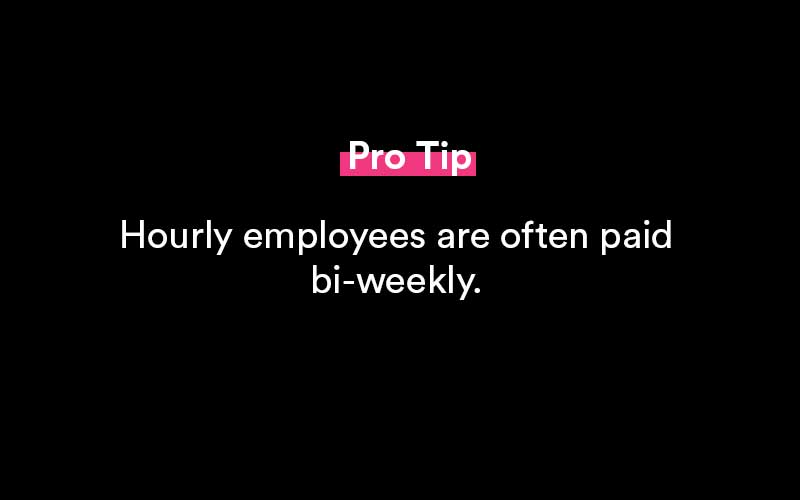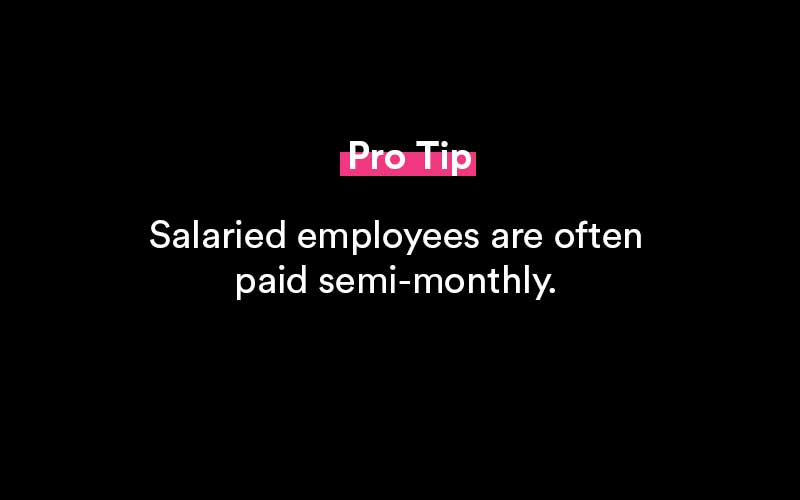Semi-Monthly Pay? Key Differences in Semimonthly and Biweekly
Understand semi-monthly pay and semi-monthly payroll. Businesses can choose from a variety of payment schedules to determine how frequently they pay their employees. Some companies prefer to pay staff weekly, while others only pay them once a month. However, semi-monthly or bi-weekly remuneration is the most frequent.
We'll define semi-monthly pay, clarify the distinctions between semi-monthly and bi-weekly pay, discuss the benefits of semi-monthly pay, and highlight the recommended pay schedules for a few popular sectors.

What is a semi-monthly pay schedule?
You'll get a paycheck twice a month if you're on a semimonthly pay schedule. The first check will arrive in the middle of the month, and the second will arrive at the end of the month or at the start of the next. The 1st and 15th of the month, or the 15th and the final day of the month, are typical semimonthly pay dates.
You will earn 24 payouts each year if you work on a semimonthly basis. Some paychecks will be larger or less than others due to the fact that months are not always the same length. Your second payment in February, for example, would only cover 13 or 14 days. The majority of other paychecks are for a 15 or 16-day period. If you're a salaried employee, your company can divide your total yearly income evenly across 24 checks if you're a permanent employee.

Semi-monthly pay calculation
Your employer will pay you twice a month, every month, if you have a semi-monthly pay schedule. A total of 24 paychecks will be issued to you every year. Because semi-monthly pay periods might vary in length by a few days, if you're a salaried employee, your company is likely to divide your compensation evenly throughout each of the 24 paychecks, regardless of the actual number of workdays each pay period. Some companies, on the other hand, pay salaried employees per pay period, resulting in minor variations in the amount of each check.
Assuming a $100k/yr salary
If you make $100,000 per year as a salaried employee and your employer issues standardized payments throughout the year, your twice-monthly checks will be $4,166.66 each before taxes. Each paycheck will contain that amount of money (less any unpaid time you take off). Some checks can be slightly more than $4,166.66 while others can be somewhat less if your company calculates the number of hours each cheque in relation to your compensation.
Employees that work by the hour do not have a predetermined salary for the year. The frequency of semi-monthly checks remains the same for these employees, but the payment amount varies depending on the number of normal hours worked, overtime hours done, and unpaid time off taken, resulting in varied check amounts each pay period.
Semi-monthly checks are usually sent on the same day each month. Most companies issue checks on the first and 15th of the month, or the 15th and last day of the month, however in principle, the company can deliver checks on any two days.
What is a bi-weekly pay schedule?
You'll get a payout every other week if you work on a bimonthly schedule. Paychecks are generally distributed on the same day each pay week, which is usually a Friday.
You will receive 26 paychecks each year if you work biweekly. If you work as a salaried employee, your salary is set, therefore your cheque will be the same every time. If you're paid hourly, each paycheck will be different since it will represent the number of hours you worked during that pay cycle, including overtime.

Bi-weekly pay calculation
The fact that you are paid semimonthly or biweekly has no bearing on your yearly compensation if you are a salaried employee. Regardless of the pay plan, you will receive the same amount each year. What differs is the amount of each paycheck and the frequency with which you receive it.
Assuming a $100k/yr salary
For example, if you make $100,00 per year and are paid semimonthly, your gross salary will be $4,166.66 each paycheck (that is, before any payroll deductions such as income tax or health benefits). Because there are two pay cycles per month, you divide 100,000 by 24 to arrive at that figure.
Your $100,000 annual salary is divided into 26 pay cycles on a biweekly payment plan. As a result, before deductions, each paycheck will be $3,846.15 every other week. You can appear to be paid less, but you actually earn two extra paychecks each year.
These numbers apply to full-time non-salaried employees as well. The key distinction is that each payment will be modified to reflect overtime hours or time off taken throughout the pay cycle.
Which pay schedules do industries use?
In many sectors, biweekly pay is the ideal schedule. Others, on the other hand, follow different timetables.
Employees in the construction, industrial, natural resource, and mining industries are often paid weekly. Because workers in these businesses frequently work variable hours throughout the week, a weekly payment plan can better represent their cash flow requirements. Employees can, for example, lose hours due to inclement weather or work overtime to meet a deadline. Overtime is defined as any hours done in excess of 40 in a week, and is counted on a weekly basis rather than two or four weeks.
Although certain financial service companies can issue monthly checks, monthly pay schedules are the least frequent across all industries. Monthly pay cycles are preferred by high-wage companies, and weekly pay cycles are preferred by low-wage ones. High-earners can generally get by getting paid only once a month. A weekly check can be required by those on a reduced income to assist pay expenses and balance their money.
Hourly employees are often paid bi-weekly and their salaries employees semi-monthly.

By industry and sector
- Manufacturing and construction companies as well as mining and natural resource companies: Prefer a weekly pay plan to a semi-monthly or bi-weekly pay schedule. Their personnel frequently work irregular hours, which might result in fewer hours some weeks and overtime hours other weeks, depending on the nature of the job and weather circumstances. Payroll administration every week makes it easy to deal with discrepancies.
- Financial services: Rather of semi-monthly, bi-weekly, or weekly checks, many financial services businesses and other high-paying sectors issue monthly checks totaling 12 per year. Salaried employees frequently make a considerable sum every year, making it simpler for them to survive on one check per month due to the size of those checks.
- Food service: Businesses such as fast-food restaurants and others who pay their employees a modest hourly salary generally pay them weekly. This allows employees to properly manage their money and account for any unpaid time off or overtime that can occur within the pay period.
Hourly workers
Frequently, a business will pay employees who work on an hourly basis through bi-weekly payroll. Or on a semi-monthly basis. It makes payroll processing simpler. And paying employees becomes a standardizes process for the business.
Employees paid on a biweekly payroll often receive benefits of this pay period.
Advantages of semi-monthly payroll
The following are some of the benefits of a semimonthly pay schedule:
Same dates
Knowing when you'll be paid on specific days might help you budget your home costs and plan monthly bill payments.
Cost-effective
Because a company only has to process payroll twice a month with a semimonthly pay plan, it saves money. Not only does this save money on payroll services, but it also saves time for employees who have to deal with payroll.
Deductions and taxes are easier
When your monthly payroll deductions (for example, health benefits) are split evenly between two monthly paychecks, it's easy to compute your take-home pay. Because you never get another paycheck in a month, that deduction will always remain the same.
Advantages of bi-weekly payroll
Many employees prefer a biweekly pay plan for a variety of reasons, including:
Predictable
Every two weeks, your paycheck will arrive on the same day. While semimonthly checks arrive on the same day each month, they can not always arrive on the same day.
Overtime pay is easier
Overtime compensation is generally calculated over the course of a week. Because your biweekly pay always covers two full weeks and never splits overtime across two pay cycles, calculating overtime compensation is much easier.
There's an additional paycheck
Twice a year, you earn a bonus salary. This extra money might be used to pay down debts or put toward savings.
It's vital to understand the difference between a semimonthly and a biweekly payment plan. You can now estimate how much money you'll earn in each paycheck, which will help you budget and prepare for the future.
Popular Resources

Featured
35+ Phone Interview Questions & Best Sample Answers
Phone interviews have become a core part of the process when attempting to find a secured placement for an open position. Companies receive massive responses from potential candidates for any..

Featured
12+ Best Questions To Ask A Recruiter
Concerning a job search, you might receive numerous offers from your recruiters. Before you choose one, you need to assess all the conditions, for which it is vital that you know everything associated with the offered position..

Featured
Answering "What Makes You Unique" In A Job Interview
Answering this question during a job interview requires more than knowing why you are unique as an individual. Yes, the true scientific answer is made up of two main components: your..

Featured
250+ Ice Breaker Questions for Life
An ice breaker question is a question that’s asked from one person to another person in order to act as a conversation starter. It brings a connection...

Featured
10 Best Answers to "What Motivates You?"
Open-ended questions like “What motivates you?” can elicit a deer-in-the-headlights reaction from job candidates if they are unprepared. It’s a broad question and can leave the interviewer..

Featured
Answering "How Did You Hear About This Position" In An Interview
A lot of interviewers ask this question - how did you hear about this position? This way they can judge you if you are a passive or an active job seeker..

Featured
8 Best Thank You Emails After an Interview (Samples, Free Templates)
Writing a thank you note after an interview says a lot about you as a potential employee. Most notably, it says that you care about the opportunities presented..

Featured
Writing a Resignation Letter (How To Write It, Samples)
Writing the perfect letter of resignation is more of an art than it is a science. And we’re going to cover how to master that art form in this full guide..

Featured
How to End a Letter (Example Salutations, Sign Off's)
Knowing how to end a business note or email is an important skill to develop. It helps portray a sense of confidence, respect and tone to your message..
